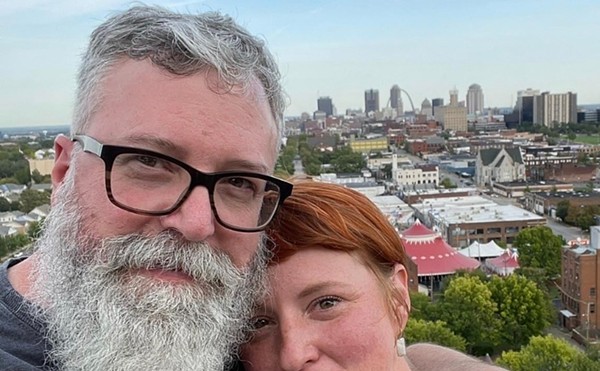The rug, created in 2002 by Navajo weaver Florence Riggs, is one of eight pictorial weavings on display from Saturday, April 24, until June 26 in the Bellwether Gallery of the Sheldon Art Galleries.
One of the four quadrants in Riggs' weaving highlights children playing near the Ferris wheel at the Navajo Nation Fair in New Mexico. In another scene a silversmith barters with a shopkeeper at a reservation trading post. Another portion of the rug shows Navajo women weaving on looms outside the octagon-shape hogans in which they live. The red-rock buttes and spires of Monument Valley, Arizona, decorate the background of another scene, which features foxes, mountain goats, coyotes and other wildlife that occupy the natural and mythological landscape of the nation's largest Indian reservation.
Another rug, created in 1983 by Navajo weaver Laura Nez, shows hooded dancers making an offering of corn pollen as grandmas, grandpas, moms, dads and children watch the ceremonial "Ye'ii bi cheii" dance.
"For me, it's exciting to see the beauty of the artistry -- the patterns, the delicacy of the weavings and the excitement of the imagery," says Olivia Lahs-Gonzales, director of the Sheldon Art Galleries.
The exhibit, "Ancient and Modern: Aesthetics and Cultural Cross-Currents in Native American Art," is part of a year-long celebration of world cultures at the Sheldon.
"The show is about how cultures intermingle and are inspired by each other," Lahs-Gonzales explains.
The Navajo weavings, which date from the 1890s to the present, are on loan from the Southwest Native American Collection of the Kennedy Art Museum at Ohio University.
The exhibit also features woven baskets from tribes throughout the Southwest. "These are very exciting and modern patterns," Lahs-Gonzales says, noting that the 1930s- and 1940s-era baskets were artistically ahead of their time.
Treasured pieces from local collections also are on display, including Hopi Kachina dolls, Plains Indian beadwork and exquisitely detailed pottery from Mississippian tribes, who lived in middle and southern Illinois more than 500 years ago.
An opening reception will be held from 5 to 7 p.m. on Friday, April 23, at the Sheldon Gallery, 3648 Washington Boulevard. For more information, visit www.sheldonconcerthall.org. -- Shelley Smithson
Silence Ain't Golden
Let's make some noise
WED 4/21
Taking a page from Joni Mitchell (who first posited that you don't know what you got till it's gone), the National Day of Silence (www.dayofsilence.org) reminds us in the most subtle way possible what our society would miss if gays and lesbians remained silent all their lives. From sunrise to sunset, GLB high-school students and their supporters across the nation will protest the bullying and harassment they often must endure by refusing to speak.
Of course, after holding it all in for the day, these same students will feel the need to release what they've retained, and so there is the Night of Noise. From 7 to 9 p.m. at the Central Reform Congregation (5020 Waterman Boulevard, call 314-361-2111, ext. 27), area GLB students and their friends and loved ones are welcome to let loose in a friendly environment. There will be guest speakers, light refreshments and a performance by Anna Roland, who is known for her support of workers' rights, queer rights and the dismantling of the patriarchy. Feel free to shout if her performance moves you: It's encouraged. -- Paul Friswold
Inna-Dada-Da-Vida
Art for fun's sake
SAT 4/24
Have you ever risen early in the morning, watched the lovely post-dawn light dance through your window and thought, "Dada is the sun, Dada is the egg. Dada is the Police of the Police"? No? Oh. Ever stabbed a knife through a dictionary and named an art movement after whatever word the blade struck? No? Um, all right. Well, have you ever drawn a mustache or a silly hat on someone in a picture? Yes? You and Marcel Duchamp both, friend! You're a total Dadaist.
That's why you should get your absurdist self to the Contemporary Art Museum St. Louis (3750 Washington Boulevard, 314-535-4660) for the 2004 Dada Dinner and Ball. Just put together a surreal ensemble (aren't you glad you didn't throw away that fez and those Rainbow Brite leg-warmers?) and get ready to dance, imbibe and admire the works of Paris-based artist Michael Lin, among others.
Tickets to the cocktail hour, dinner and ball are a bit steep at $250 (and no, smart guy, you can't be all "Dada" and pretend those lasagna noodles are dollars), but entrance to just the ball, which begins at 9:30 p.m., can be had for a mere $50 -- and every last bit of it goes toward the museum's education and outreach programs. Bumblebees! -- Brooke Foster
OK, Computer
WED 4/21
Musical anthropologists of the future are going to have a tough time trying to determine a catchy, epoch-defining name for this current climate. The range of music being made now beggars easy classification; garage rock, slick pop, rap (and various permutations thereof) and the electronic/DJ movements have all had their brief time as the trendsetter, but nothing has truly stuck in the public consciousness as being the definitive music of our time. Perhaps grizzled visionary Neil Young's "Computer Age" will be the winning entry. Cheap, ubiquitous, portable and faster than ever, computers have revolutionized the creation of music, enabling people to compose and record and reproduce whatever sound it is they hear inside their heads.
The music departments of Forest Park Community College and Washington University celebrate and demonstrate their prowess on these clever machines with Digital Circles 04, a free outdoor concert of computer music. Held at noon in the Theater Atrium of Forest Park's campus (5600 Oakland Avenue, 314-644-9769), Digital Circles offers a chance to hear the music of today as it's being realized and refined by the progenitors of a future age. Just remember, what sounds outré now will sound quaint in ten years. -- Paul Friswold





